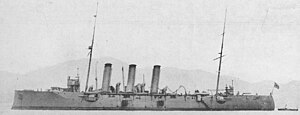Niitaka-class cruiser

Niitaka in 1922
|
|
| Class overview | |
|---|---|
| Name: | Niitaka class |
| Builders: |
|
| Operators: |
|
| Built: | 1901–1904 |
| In commission: | 1904–1936 |
| Completed: | 2 |
| Lost: | 1 |
| General characteristics | |
| Type: | Protected cruiser |
| Displacement: | 3,366 long tons (3,420 t) |
| Length: | 102 m (334 ft 8 in) w/l |
| Beam: | 13.44 m (44 ft 1 in) |
| Draft: | 4.92 m (16 ft 2 in) |
| Propulsion: | 2-shaft VTE reciprocating engines; 16 boilers; 9,500 hp (7,100 kW) |
| Speed: | 20 knots (23 mph; 37 km/h) |
| Complement: | 287-320 |
| Armament: |
|
| Armor: |
|
The two Niitaka-class cruisers (新高型防護巡洋艦 Niitaka-gata bōgojun'yōkan?) were protected cruisers operated by the Imperial Japanese Navy. Both participated in numerous actions during the Russo-Japanese War and in World War I.
The Niitaka class was the second cruiser class built to a completely Japanese design and was ordered as part of the 2nd Emergency Fleet Replenishment Program, with a budget acquired by the indemnity awarded to Japan by the Treaty of Shimonoseki ending the First Sino-Japanese War. These small cruisers were intended for high speed reconnaissance. The lead ship Niitaka was built at the Yokosuka Naval Arsenal, Yokosuka, Kanagawa, which already had considerable experiencing in building small cruisers. Its sister ship, Tsushima, was built at the new Kure Naval Arsenal, at Kure, Hiroshima and took considerably longer to complete.
In terms of design, the Niitaka class was very conservative in layout and similar to, but somewhat larger and the earlier Japanese-designed Suma. The increased displacement, heavier armor and lower center of gravity resulted in a more seaworthy and powerful vessel than Suma, and enabled Tsushima to outclass many other contemporary protected cruisers.
In terms of armament, it is noteworthy that the Niitaka-class cruisers were not equipped with torpedoes. Observing problems experienced by the United States Navy during the Spanish American War with torpedo reliability and the dangers of sympathetic detonation, it was decided not to use this weapon on the new cruisers. The main battery was standardized to the QF 6 inch /40 naval gun used on most contemporary Japanese cruisers.
...
Wikipedia
